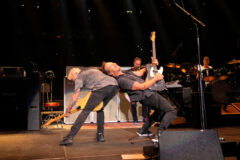If you’ve read enough comic books, the opening scene from The Umbrella Academy‘s first issue doesn’t seem all that unusual: A tank-size pro wrestler wallops an interterrestrial squid with an atomic elbow, which then causes 43 women around the world to spontaneously give birth to superhero babies. Surreal and bizarre, yes, but par for the course in the feverish, physics-defying universe of men in tights. The real surprise may come in the credits: The series is written by Gerard Way, frontman for My Chemical Romance.
Way has never made a secret of his fascination with vigilante crime fighters and mind-controlling mutants: He worked at a comic-book store in New Jersey, studied at Manhattan’s School of Visual Arts, and interned at DC Comics before forming MCR in 2001. His Umbrella Academy, drawn by Brazilian artist Gabriel Bá and published by Dark Horse, replicates the delirious anything-can-happen tone of such series as Grant Morrison’s Doom Patrol. “If I write a song like ‘I Don’t Love You,’ it’s completely obvious,” Way says. “But in a comic, I can have ten-year-old children fighting a berserk Eiffel Tower, and it’s harder for people to say, ‘Oh, he’s writing about himself.’ “
Coheed and Cambria’s Claudio Sanchez came from a similar fanboy background, having grown up devouring the Grand Guignol imagery of Spawn and Ghost Rider. He’s been working on comics since 2004, as a way to flesh out the densely packed cosmology of his band’s albums. “I’m not the kind of guy who likes to wear his heart on his sleeve, so I use the comics to embellish or hide my story,” he says. His latest, The Amory Wars (Image), is a labyrinthine sci-fi series involving “the 78 planets of Heaven’s Fence.” Okaaay.
This kind of geek cred comes easily for Way and Sanchez, but it wasn’t always that way. Rock-to-comic crossovers from the ’60s, featuring the likes of the Beatles and the Monkees, were nothing more than product tie-ins, like lunchboxes or posters. Credit Kiss for taking things one step further. In the late ’70s, Marvel teamed up with the already cartoonish rockers for two books, including one it boasted was “printed in real Kiss blood,” and which featured photos of band members pouring vials of the red stuff into vats of ink. (The hard-rock harlequins are still at it, currently appearing in a deeply corny futuristic run called Kiss 4K: Legends Never Die.)
As comics gain cultural cachet (The New York Times Magazine has a “Funny Pages” section; artists Alison Bechdel, Marjane Satrapi, Chris Ware, and Adrian Tomine have published highly regarded books; there are college courses on “the graphic novel”), more musicians have used the medium as a way to branch out into storytelling. Courtney Love, Wu-Tang Clan, and Rob Zombie all dipped into the inkwell earlier this century.
More recently, DC Comics’ mature Vertigo imprint recruited Percy Carey (a.k.a. MF Grimm) to tell his story in graphic-novel form. Sentences, drawn by Ron Wimberly, unflinchingly chronicles Carey’s descent into drug dealing, the shooting that left him in a wheelchair, and his eventual salvation through hip-hop. At first, the rapper planned on doing something with “parallel universes and wormholes and powers,” but, inspired by the quotidian epiphanies of Harvey Pekar’s American Splendor series, he realized his own life could make for a compelling narrative. Since the book debuted in September, it’s won raves from National Public Radio and the Los Angeles Times.
The crossover bug has even struck old-guard acts like Eurythmics’ Dave Stewart — who provided the concept for Virgin Comics’ time-tripping series Walk-In — and Duran Duran, currently working on a miniseries for later this year. Neil Young has teamed up with Vertigo for an adaptation of his 2003 concept album Greendale, which follows an eco-conscious family in a California town. But don’t expect the final product, due in 2009, to hew too closely to the source material. “I was really trying to capture the essence of the album,” writer Joshua Dysart says. “And I think Neil wants to do something a lot more comic-booky and supernatural.”
Similarly, the fantastical art pop of Tori Amos has inspired a still untitled anthology of comics based on her songs. “Obviously, I’ll need to have a level of trust to turn over these songs to each writer,” Amos says. “With the unknown, there can be a feeling of reticence, but that in itself can be sexy.” More than 70 cartoonists have signed up so far. “This is something that Tori and I have been talking about doing for at least 15 years,” says editor Rantz A. Hoseley.
Even as more musicians use comics as a creative form, there are still plenty of promotional tie-ins. Avril Lavigne’s Make 5 Wishes (Del Rey), a two-volume 2006 manga series by Dysart and artist Camilla d’Errico, apparently had little to zero involvement from the singer. In an interview with Comic Foundry magazine, Lavigne admitted that she doesn’t read comics herself, and that Make 5 Wishes was “just a small, little thing on the side…for the kids.” For his part, Dysart says, “I have not, to this day, actually heard an Avril Lavigne song. To say [the book is] anything other than a capitalist endeavor is to be a big fat liar. But I think we did a pretty good job, as far as selling out goes.”
On the flip side is Way, whose connection to the art form is obviously more earnest and authentic. “Back in the day, a lot of rock bands wouldn’t have hung out in a comic-book store,” he says. “But the kind of people making music now are the smart kids who probably sat in the back of the class, wearing black. That’s a comic-book fan where I come from.”





